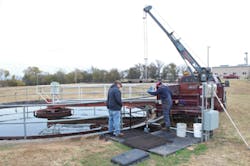Sludge Handling in the Sooner State
By Steve London
Perry, Okla., about 60 miles due north of Oklahoma City, is a small community of about 5,000 residents. It serves as the county seat for Noble County, with direct access from Interstate 35 and U.S. 412. Although not large, Perry is quite proud of what it represents, as evidenced in its Home Rule Charter, which underscores the city’s commitment to “encourage efficient and business-like methods in the transaction of municipal affairs, promote civic advancement and general welfare and protect the human rights and personal dignity of all persons.”
Overview of the pump installation with clarifier on left.
Perry is also serious about its environmental responsibilities, including its wastewater treatment plant, which has a maximum rating of 2 million gallons per day (MGD) and receives an average of 500,000 gallons per day (GPD) of wastewater. The plant consists of a manual coarse bar screen, two aeration basins, two clarifiers, and disinfection by chlorination.
In December 2015, the Perry City Council accepted a Rural Energy for America Program (REAP) grant from the Northern Oklahoma Development Authority (NODA) in the amount of $49,500 (later reduced to $48,015 due to state budget cutbacks) for construction of a new sludge thickening/conditioning basin at the wastewater treatment plant.
The council then authorized a Community Development Block Grant application to the Oklahoma Department of Commerce in the amount of $49,500 to supplement the REAP grant from NODA to install a 30-cubic-yard sludge dewatering container filter (sludge box) at the plant. The project also included the installation of a polymer injection system, retrofitting five existing sludge drying beds and the replacement of the return activated sludge (RAS) pumps at the existing clarifiers. The total cost of the project was $350,000 and was completed by Young Contracting LLC (Oklahoma City).
Clarifiers adjacent to sludge basin at the Perry wastewater treatment plant.
Sludge was previously moved at the plant by two rail-mounted submersible non-clog pumps that were old and failing and which often clogged due to material bypassing the bar screen at the lift station. However, the primary impetus for their replacement was the new sludge box system. The sludge box thickening/conditioning system consists of a polymer mixing/injection system and a dumpster-like structure to dewater the biosolids so that they can be stored and stabilized on retrofitted sludge drying beds until such time that the solids can be land applied.
The city needed to be able to discharge sludge at two different rates: one for sludge returning to the headworks (RAS) and another for sending material to the sludge box. The system is designed to speed up dewatering biosolids as a replacement to existing sand drying beds.
Perry’s consulting engineer, Monsoon Consultants (San Luis Obispo, Calif.), originally recommended two different sized pumps in its design: one pump for return and one pump for waste to accommodate the sludge box requirements. However, local Xylem distributor Automatic Engineering (Tulsa, Okla.) suggested Xylem’s Flygt Concertor™ intelligent pumping system so that each station would have 100 percent redundancy. In addition, the plant is also considering SCADA upgrades, which the Concertor system will easily accommodate.
Pump on guide rails descending into the well.
A Perfect Fit
Xylem’s Flygt Concertor pumping systems combine fully integrated controls with IE4 motor efficiency, N-hydraulics, and intelligent functionalities. The built-in control system automatically adapts to the changing pumping environment, delivering the optimal level of performance and therefore lowering the overall cost of ownership. The built-in intelligence also makes it easier to set up and operate, as well as allows for a significantly smaller footprint, including controls.
The hydraulic end of the Concertor system is designed for clog-free performance, while the adaptive N-impeller moves axially upward when needed, allowing bulky fibrous material and debris to pass through smoothly. After the debris has passed, the hydraulic pressure returns the impeller to its original position. Not only does this prevent clogging and reduce stress on the shaft, seals, and bearings, it also enables a sustained low usage of energy.
The ability to quickly and easily change flow rates was very appealing to the Perry wastewater treatment plant staff. As for replacement, nothing unusual was encountered in the project: the old pumps were simply pulled out and replaced with the Concertor systems. Pump controls were added in a new building, which also houses the polymer mixing and injection system.
The new pumps went into service in April and May 2017 and the staff is thrilled that they have experienced no clogging. Depending on the static head on the pumps and the lift head between the clarifiers, flow rates vary from 85 to 370 gallons per minute (GPM), depending on the pump speed. Personnel are eagerly awaiting commencement of the SCADA project, which is expected to dramatically smooth varying the pump flow rate, speed, and power settings.
New control panels for RAS pumps.
When asked about the performance of the new pumping systems, the design engineer, Blaine Reely with Monsoon Consultants, stated that “the new Concertor systems have been operating flawlessly and have given our operator the flexibility to perfectly match our RAS flows, either in the return mode or the wasting mode, with the ever-changing conditions that we experience on a daily basis.”
Perry may be on the smaller side when it comes to population, but its administration, treatment plant personnel, pump distributor, and consulting engineer all thought big to improve its sludge handling operations. WW
About the Author: Steve London is president of Steven London Associates (Apollo Beach, Fla.). He has extensive background as a writer and editor specific to municipal water treatment technologies. For the past 19 years, his company has developed application articles that highlight various solutions for water management professionals. London can be contacted at [email protected] or (813) 645-0209.




